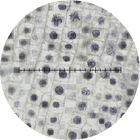On the first day of biology lab, students begin working with microscopes, but, "You know they're probably not going to see anything," says Bob Ketcham, Laboratory Coordinator, Department of Biological Sciences.
Ketcham thought: What does it take to help someone be successful with the microscope? Could technology help?
Ketcham began working with PRESENT staff in the fall of 2002 on one aspect of a course redesign grant for BISC 104, an introduction for non-majors. The goal was to develop a simulation that would allow students to learn in the same way they do on a real microscope and improve their actual lab experience.
Skilled microscope use is essential for the 300-400 non-majors each semester. Ketcham often saw students struggling to see specimens and becoming disinterested as their frustration grew. Sometimes, they even pretended to be successful. Students must be quite comfortable with a microscope to get the most out of lab and learn basic biological concepts.
The challenge is to provide individual instruction, says Ketcham. "Students understand the lecture if they work on the microscope to see cells." However, lab instructors cannot spend a lot of time with every student needing help. Moreover, it is not possible for an instructor to share the view through the microscope while demonstrating proper use.
Today, students are first directed to a web site to use a virtual microscope. They begin with a narrated tutorial of the lab replica and are shown a checklist displaying every setup step. As a student begins using the microscope, the checklist promotes success by indicating when a step is completed or needs to be repeated.

Sample specimen from microscope simulation
Students see the outside of the microscope and can also look through the microscope at a specimen. These views can be switched at any time, but a student will not see a specimen unless the proper steps are followed. Students view images of actual specimens and can adjust all microscope controls including the light switch, rheostat, magnification, stage position, oculars, course and fine focus, and iris diaphragm.
Initially, Ketcham and PRESENT staff hoped to find an existing virtual microscope or similar demonstration to meet their needs. Very few simulations were available and those had limited instructional value. "The videos would demonstrate something on a microscope that didn't apply to us," says Ketcham.
Becky Kinney provided the Macromedia Flash programming expertise to create a simulation from scratch. Over several months, Ketcham and Kinney outlined microscope use, defined requirements for the virtual model, discussed technical challenges, made diagrams and storyboards, wrote the narration, selected technology, and tested prototypes. The tool was released in the spring of 2003.
Since its launch, Ketcham reports success. Students are having fewer troubles with the lab microscopes and the lab received a very high rating in an end-of-semester survey. "We're not getting stuck at the level of using the microscope, and can discuss, for example, the properties of bacteria and how they relate."
The microscope simulation is beginning to get national exposure. In the spring of 2003, Ketcham shared the web site through a posting on a Biolab listserv for college and high school-level instructors, and that fall, it appeared in the online version of Cell Biology Education . The project is also included in the MERLOT educational resource directory.
"What we know about cells is extraordinary," says Ketcham. With the success of the virtual microscope, students will be able to comprehend and appreciate more of these discoveries.
